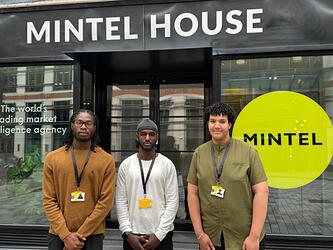Under the radar: Researching niche trends
Veganism is commonplace these days, a fixture on restaurant menus and in supermarket aisles, with companies fighting to bring out vegan versions of their most famous products.
But veganism was not always part of the mainstream. In November 1944, the word ‘vegan’ was coined by a group of six non-dairy vegetarians in a meeting called by Donald Watson. The movement started as a tiny subculture within the vegetarian movement, and eventually grew to the lifestyle seen across the world today.
There are numerous other examples of niche trends and subcultures hitting the big time, from punk to Pokémon, and much in between. But does the idea of a subculture resonate with a generation brought up in a digital world, where new communities and information are at our fingertips? And how should brands interact with new trends before they reach the general public?
Market research company The Nursery carried out a project to examine subcultures because of a relative lack of research, with much media coverage of the area bemoaning the ‘death of the subculture’ and the role of the internet in its demise.
The research team wanted to see how many people were into subcultures and what modern subcultures look like. Subcultures were deemed to be communities of people who exist alongside mainstream society but remain separate, and could be based around a number of areas, including music, food or religion.
This led to a small qualitative study – with 25 to 30 people – exploring their views on the subcultures they had joined, followed by a nationally representative survey with 1,805 people that examined the proportion of people involved in a subculture, as well as their attitudes and behaviours. The survey found that 56% of participants deemed themselves to be an active member of a subculture: 75% considered it a key part of their identity, with a wide range of reasons for joining.
“For some people, it was about creativity; for other people, it was more about making friends,” says Natalie Webb, associate director at The Nursery.
The Nursery’s subcultures research has fed into another project carried out with marketer Helen Edwards, ‘Marginal to Mainstream’, which has since been published as a book based on the findings.
The researchers explored 21 marginal behaviours, such as naturism or ‘living off the sea’, and attempted to predict their likelihood of breaking through and becoming popular. This was done through a nationally representative study in the US and UK, as well as qualitative research through 10 focus groups across the two nations.
Subcultures and niche trends can burst into the mainstream – see punk, for example – but quite often live outside the knowledge of most of the population. However, this does not mean that companies should ignore them. As the book says, “if you’re looking for high growth, don’t start with something that’s already grown; start, instead, from something small, marginal, promising”.
Finding links
Steve King, co-founder and chief executive at Black Swan Data, says that the most important factor behind determining which niche trends and subcultures enter the mainstream is their connection to wider societal shifts – for example, veganism’s relationship with the broader environmental movement and shift towards healthier lifestyles.
“The trends that appear and disappear aren’t necessarily connected to bigger trends,” King explains. “There’s no consumer driver that is changing people’s lives. You can tell if a trend is going to be successful or not by the environment around it and what it is connected to, and whether those things are also on a trend journey. They can become quite predictable once you understand the science behind it.”
How a brand and society interact with one another provides the best prediction of success (or otherwise) for a company’s foray into a niche trend, according to Martin Raymond, editor-in-chief and co-founder at The Future Laboratory.
“It’s about using the current trend filters in the market, then overlaying a brand filter for what it means, what the future of this sector is within the context of the likely future scenario,” he explains. “We use all this to forward extrapolate trends that will impact the way businesses work, from customer services to developing new products and how to market them.”
Then there is the role of the internet. “The internet has changed trend forecasting, with an ever-faster lens speeding up the process,” Raymond says. “Consumers and businesses are better connected with their communities through social networks; we can track innovators more efficiently, and we are entering an era of Web3 that looks set to impact the way communities are created.”
This does not mean that brands should automatically seek to engage with every niche trend or subculture entering into wider public consciousness. “We looked through brands who had associated themselves with a subculture and had done it well,” says The Nursery’s Webb. “But the biggest lesson was that, if you are going to do it, you have to be respectful. You can’t just take the aesthetic of a subculture and stick it on a product. You have to be part of the subculture – you can’t just sell a product to a subculture because you will probably not get it right unless you are [part of] one.”
Take shoe brand Dr Martens, which has long been associated with underground movements such as the punk and Goth subcultures, and has sought to maintain its alternative credentials despite its rise in worldwide popularity.
Black Swan’s King agrees that businesses must consider whether they have earned the place to get involved in a subculture – whether they can engage without being seen as bandwagon-jumpers or alienating their existing consumer base.
“Sometimes, a trend is a step too far for a brand,” King adds. “Smart brands will look at what trends they are already associated with and, therefore, whether they have a ‘right to play’ in the area where the trend is. They will ask that question before they go in. If they don’t, they can look idiotic.”
This article was first published in the July 2023 issue of Impact.

We hope you enjoyed this article.
Research Live is published by MRS.
The Market Research Society (MRS) exists to promote and protect the research sector, showcasing how research delivers impact for businesses and government.
Members of MRS enjoy many benefits including tailoured policy guidance, discounts on training and conferences, and access to member-only content.
For example, there's an archive of winning case studies from over a decade of MRS Awards.
Find out more about the benefits of joining MRS here.













0 Comments